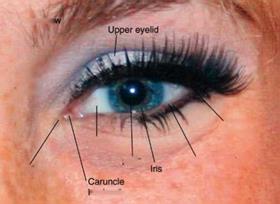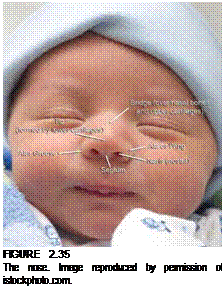Surface anatomy is the study of the configuration of the surface of the body, especially in relation to its internal parts. The way we are put together beneath the skin manifests itself to a great extent outwardly and is visible. Our skeletons and musculature give us our basic shape, and our skin is the covering that gives those internal structures one overall form that is each of us. From birth, as we grow and develop, our surface anatomy changes because our internal anatomy is changing as well.
The reason that understanding anatomy is so important for us as makeup effects artists is that much of what we do is based on surface anatomy being dictated by underlying anatomy. It is in the understanding of internal anatomy that we are able to know why there are bumps and hollows on the external surface of the body.[11] To create prosthetic appliances that will be believable, even if the design is somewhat stylized, we must know what people of every color, gender, size, and shape look like and how they move.
Remember also that when it comes to designing prosthetic makeup effects, you can add to the anatomy of the actor to create the new character, but you cannot take away. For example, if you are given the task of creating the makeup effects for a production with emaciated, starved, and abused concentration camp prisoners, the direction in which you can go is limited. To create a character of skin and bones requires one of the following:
■ Extremely skinny actors
■ CGI characters
■ Shadow and highlight foundation makeup that may give a stylized impression of a gaunt appearance but will not in actuality make the actors thin
For individuals with no body fat and very little muscle mass, their surface anatomy will show much of the body’s skeleton clearly defined just beneath the skin. For example, for the film The Machinist, actor Christian Bale was willing to lose one third of his body weight to play a character in a perilous downward spiral emotionally, physically, and mentally. And he did it.
That could not have realistically been achieved any other way than physically, and had the character been physically heavier, his impact would have been negatively compromised. Was what the actor chose to do wise and healthy? Probably not, but Christian Bale has done several films since The Machinist and is physically
![]()
![]()
 |
||
 To be consistent through out this text, we also use the labels shown here for individual facial features (eyes, nose, ears, and mouth) as well as other anatomy discussed in this chapter in the chapter on sculpting the makeup. The nose, ears, and mouth are potential problem areas for undercuts during the moldmaking process.
To be consistent through out this text, we also use the labels shown here for individual facial features (eyes, nose, ears, and mouth) as well as other anatomy discussed in this chapter in the chapter on sculpting the makeup. The nose, ears, and mouth are potential problem areas for undercuts during the moldmaking process.
 |
 |
Some people have attached earlobes, but most people’s lobes are free. In fact, free earlobes are twice as common as attached lobes. As I’m sure you’ve already noticed, in special makeup effects, ears are nothing but undercuts—severe undercuts. For the uninitiated, an undercut is any part of a sculpture that creates an overhang that when molded will be grabbed by the other part of the mold and won’t let go, making it either impossible to get the mold halves apart or breaking off part of the sculpture or mold.
